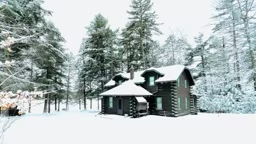
Energy efficiency is on everyone’s mind. When it comes to home building, it’s actually mandated by increasingly stringent codes. Some people think that there’s no way to make an air-tight log home, but that’s simply not true.
The fact is that the primary air-penetration problem areas are exactly the same in a log home as they are a conventionally constructed house, with the main culprits being windows and doors.
Crawl spaces, unfinished basements and where roofing systems meet the walls follow close behind. Then there are auxiliary areas where holes are created in the envelope for electrical outlets, skylights, dryer vents, bathroom exhaust fans, A/C vents and ductwork. Even recessed can lights can cause an air breach, if not properly insulated.
And it’s not only uninvited air that comes in; so does everything associated with that air, like dust, pollen and other irritants that can create health issues. So how to you win the war against air leakage? Let’s focus on the biggest perpetrators: windows and doors.
In a full-log home, settlement has to be taken into account when installing and sealing windows and doors. When windows are set, the installer typically does a good job of inserting the window into the buck (the casing that the window attaches to, which then is attached to the log walls, allowing the window to stay in a static location as the logs move). It’s the area between the buck and the logs where the air could leak through, because that’s where the builder intentionally leaves room for settling.
Even so, there are techniques to properly insulate and seal this space so you can have an air-tight log home and still accommodate for movement. For example, after the logs are cut and before the bucks are inserted, your builder should ensure that the window openings have straight, linear cuts. If they aren’t even, you open yourself up to issues. If one log is even as little as 1/4-inch shorter than the one above or below it, there will be a gap. As the logs settle, that gap could allow air to infiltrate.
The fix is as easy as planing off that edge. Next, it’s critical that before the windows/bucks are installed per your manufacturer’s system, the builder inserts “sill seal,” a compressible foam sealant that comes in a roll 1/4-inch thick and up to 10-inches wide, into the cavity. Once the buck is nailed into the logs, the sill seal fills the gaps; but because it’s not adhesive, it allows the logs to slide and settle properly.
Then, when the windows are completely in place, the entire buck should be sealed with a bead of caulk, which will then be swathed in window tape. Inside the home the same procedure applies, except most builders use a pliable, compressible spray foam to fill in the interior cavity. (A note of caution when it comes to spray foam: less is more. This stuff expands – a lot. Use too much and it will push its way outside.)
Finally, all these safeguards will be concealed by decorative window trim, inside and out. At this point, the window is sealed and, if done properly, will be about 98 percent effective at eliminating unwanted air infiltration/escape. The procedure for doors is essentially the same, with the addition of securing the threshold with heavy beads of caulk. The threshold is an area that a lot of people overlook but where air has a huge opportunity to move in. Don’t neglect it.
It goes without saying that these extensive measures to shore up your house will be for naught if you don’t invest in quality windows and doors. Make sure you buy Energy Star rated materials that have an appropriate U-factor for your climate zone and meet or exceed local building codes. But with proper components and construction techniques, your air-tight log home will be snug and secure.
Dan Mitchell owns Eagle CDI in Tennessee and has built close to 100 log homes in his 30-year career. He’s the Knoxville Home Builders Association 2015 Builder of the Year.






_11868_2023-04-27_10-18-256x288.avif)




